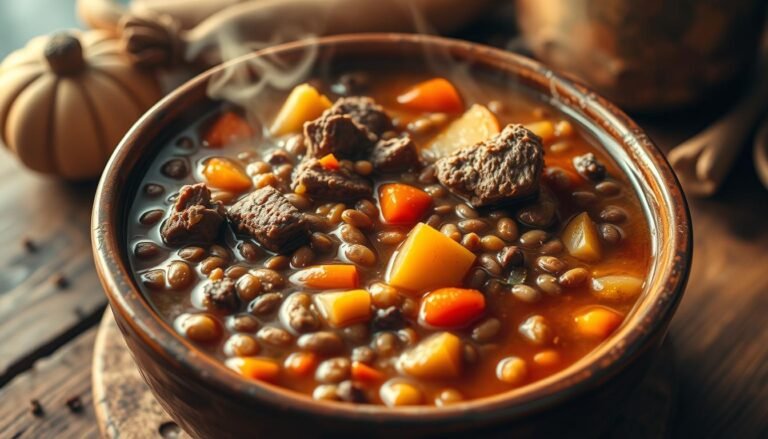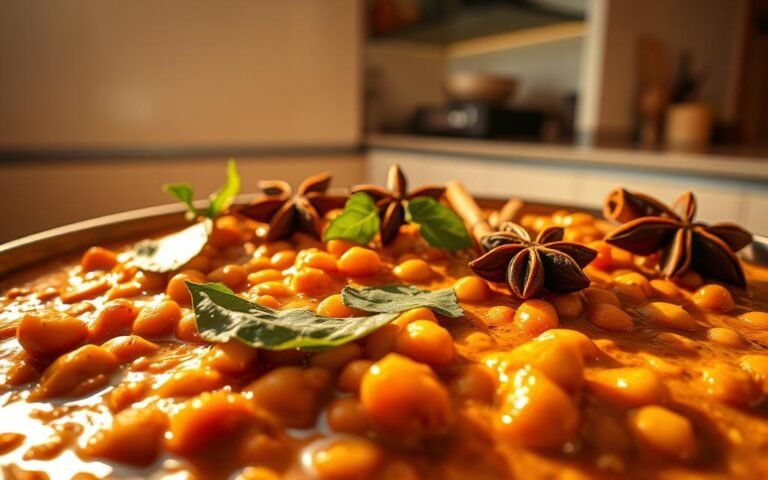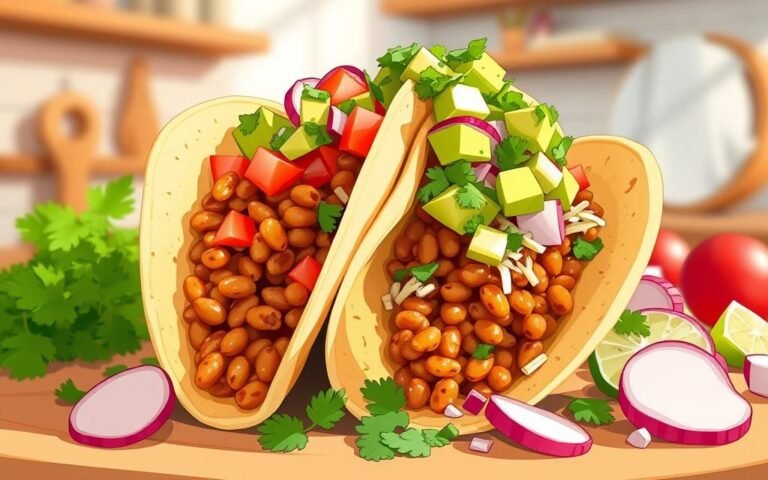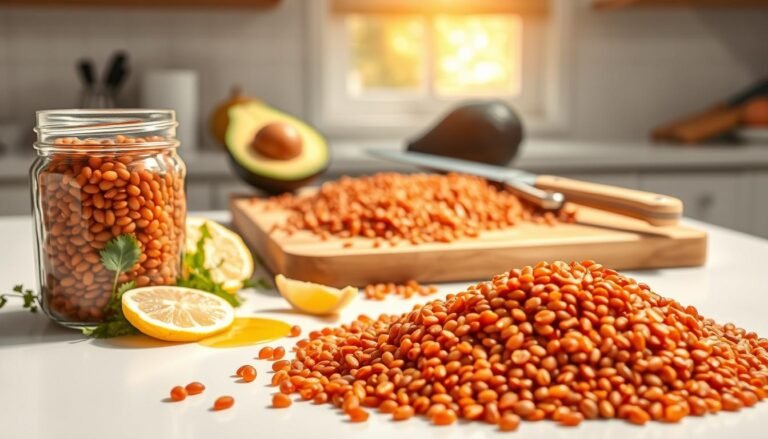Lentils are a nutritional powerhouse, offering a rich source of protein, fiber, and essential minerals. They are also environmentally friendly and budget-friendly, making them an excellent addition to a variety of dishes.
Lentils come in various colors and textures, each with its unique flavor profile and culinary uses. Whether you’re making a hearty stew or a simple salad, cooking lentils correctly is key to bringing out their full flavor and nutritional benefits. A well-cooked lentil dish can be a game-changer for vegetarians and meat-lovers alike.
Key Takeaways
- Understand the different types of lentils and their uses
- Learn simple preparation techniques for cooking lentils
- Discover flavor tips to enhance your lentil dishes
- Get tips on achieving perfect results every time
- Explore the nutritional benefits of incorporating lentils into your diet
The Versatile World of Lentils
Rich in history and nutrition, lentils are a versatile ingredient that can be incorporated into a multitude of dishes. They have been a staple in various cuisines around the world, particularly in vegetarian and vegan diets, due to their high nutritional value.
Nutritional Benefits of Adding Lentils to Your Diet
Lentils are a powerhouse of nutrition, offering a rich source of plant-based protein, dietary fiber, and essential vitamins and minerals. They are known to aid in digestion and promote a feeling of fullness, making them an excellent addition to weight management diets. For more insights on the versatility of lentils, visit The Versatile Lentil.
The nutritional benefits of lentils can be summarized in the following table:
| Nutrient | Benefit |
|---|---|
| Protein | Essential for muscle repair and growth |
| Fiber | Aids in digestion and satiety |
| Iron | Crucial for healthy red blood cells |
| Folate | Important for cell division and growth |
Why Australian Kitchens Should Embrace Lentils
Australian kitchens can greatly benefit from incorporating lentils into their cooking repertoire. Not only do lentils offer a nutritious alternative to meat, but they are also environmentally friendly, requiring less water to cultivate compared to many other protein sources. By embracing lentils, Australian cooks can create dishes that are not only delicious but also sustainable.
Lentils can be easily integrated into various Australian dishes, from hearty stews and soups to salads and curries. Their versatility and nutritional profile make them an ideal ingredient for modern cooking.
Types of Lentils and Their Unique Properties
Understanding the different types of lentils is crucial for achieving perfect results in your recipes. Lentils are a staple ingredient in many cuisines around the world, particularly in Australian kitchens where diverse culinary influences converge. With various types to choose from, each offering unique textures and flavors, lentils can elevate a wide range of dishes.
Brown Lentils: The Everyday Staple
Brown lentils are the most commonly used variety, known for their mild flavor and firm texture. They hold their shape well after cooking, making them ideal for hearty soups, stews, and salads. Brown lentils typically take about 20-30 minutes to cook.
Red and Yellow Lentils: Quick-Cooking Varieties
Red and yellow lentils are known for their quick cooking times and ability to break down into a soft, mushy texture. They are perfect for pureed soups, dals, and Indian-inspired dishes. These lentils cook relatively quickly, usually within 15-20 minutes.
Green Lentils: Firm and Flavorful Options
Green lentils have a slightly peppery flavor and retain their shape when cooked, making them suitable for salads and side dishes. They take a bit longer to cook than red or yellow lentils, typically requiring 30-40 minutes.
Black Beluga Lentils: The Gourmet Choice
Black beluga lentils are small, shiny, and resemble caviar. They have a robust, earthy flavor and firm texture, making them a great addition to upscale dishes and salads. Black beluga lentils cook in about 20-25 minutes.
For more detailed information on the various types of lentils, you can visit Bon Appétit for an in-depth guide.
By understanding the unique properties of each lentil type, you can make informed choices for your recipes, ensuring delicious and satisfying results. Whether you’re a seasoned cook or a beginner, incorporating the right type of lentil can elevate your cooking to new heights.
Essential Kitchen Equipment for Perfect Lentils
The journey to perfectly cooked lentils begins with selecting the right kitchen equipment. Having the appropriate tools not only simplifies the cooking process but also ensures consistent results.
Recommended Pots and Cookware
A medium-to-large saucepan is ideal for cooking lentils, as it allows for even heat distribution and sufficient space for the lentils to expand during cooking. Stainless steel or enameled cast iron pots are recommended due to their heat retention properties and non-reactive nature.
Helpful Tools for Preparation and Serving
In addition to a good pot, a fine-mesh sieve is crucial for rinsing lentils effectively, removing any debris or impurities. Other helpful tools include a wooden spoon or silicone spatula for stirring and a ladle for serving.

By equipping your kitchen with these essential tools, you’ll be well on your way to cooking lentils like a pro. Whether you’re a seasoned chef or a beginner in the kitchen, having the right equipment makes all the difference in achieving perfect results.
- Medium-to-large saucepan
- Fine-mesh sieve
- Wooden spoon or silicone spatula
- Ladle
With these tips and the right equipment, you’re ready to start cooking lentils with confidence.
Proper Lentil Preparation Techniques
To unlock the full potential of lentils, it’s essential to start with the right preparation methods. Proper preparation can make a significant difference in the final texture and flavor of your lentil dishes.
Sorting and Rinsing: The Critical First Step
Sorting and rinsing lentils is a crucial step that removes debris, stones, and broken lentils, ensuring a clean and even cooking process. Rinsing lentils under cold running water helps to remove any impurities and excess starch, resulting in better texture and flavor.
Key steps for sorting and rinsing lentils:
- Spread lentils on a flat surface to inspect for debris
- Rinse lentils under cold running water
- Drain and repeat the rinsing process if necessary
The Soaking Debate: When It’s Necessary
Soaking lentils can reduce cooking time, but it’s not always necessary. Some lentil varieties, like red and yellow lentils, cook quickly without soaking, while others, like green and brown lentils, may benefit from soaking to reduce cooking time.
Soaking can also help to rehydrate lentils, making them cook more evenly. However, if you’re short on time, you can still achieve great results without soaking.
Quick-Soak Methods for Time-Pressed Cooks
For those in a hurry, quick-soak methods can be a lifesaver. One method is to boil lentils in water for 2-3 minutes, then let them soak for an hour. This can significantly reduce cooking time while still achieving tender results.
By following these proper lentil preparation techniques, you’ll be well on your way to creating delicious and satisfying lentil dishes that showcase the versatility and nutritional benefits of these incredible legumes.
Cooking Lentils: The Fundamental Methods
To unlock the full potential of lentils, it’s essential to grasp the basic cooking methods that bring out their best flavor and texture. Cooking lentils is a straightforward process that involves understanding the right water-to-lentil ratios, cooking times, and techniques for testing doneness.
Perfect Water-to-Lentil Ratios
The ratio of water to lentils varies depending on the type of lentils you’re cooking. Generally, for most lentil varieties, a 2:1 water-to-lentil ratio is recommended. However, green and black lentils might require a slightly higher ratio due to their firmer texture. It’s crucial to adjust the water level to achieve the desired consistency, whether you’re aiming for a creamy stew or a firmer salad addition.
Cooking Times for Different Varieties
Cooking times can significantly differ between lentil varieties. Red and yellow lentils tend to cook quickly, often within 20-25 minutes, while brown lentils may take around 30-40 minutes. Green and black lentils hold their shape longer and can take up to 45 minutes to cook. Understanding these cooking times is key to preparing lentils that are neither undercooked nor mushy.
How to Test for Perfect Doneness
The best way to check if your lentils are cooked to perfection is by tasting them. They should be tender but still retain some firmness. Overcooked lentils become mushy and unappetizing. For a more precise method, you can also check by mashing a lentil against the side of the pot; if it mashes easily, it’s done.
By mastering these fundamental cooking methods, you’ll be well on your way to preparing delicious lentil dishes that are sure to impress. Whether you’re making a hearty lentil soup or a flavorful lentil salad, the right cooking techniques make all the difference.
Stovetop Lentil Mastery
Lentil cooking on the stovetop offers a level of control that can lead to perfectly cooked results. This method allows cooks to adjust heat and liquid levels easily, ensuring that their lentils are cooked to the desired texture.
The Basic Simmering Technique
Simmering is a fundamental technique for cooking lentils on the stovetop. To start, combine lentils with an appropriate amount of water or broth in a pot. A general rule of thumb is to use about 2-3 cups of liquid for every 1 cup of lentils. Bring the mixture to a boil, then reduce the heat to a gentle simmer. As one chef notes, “The key to perfectly cooked lentils is a gentle simmer, which helps preserve their texture and flavor.”
“The key to perfectly cooked lentils is a gentle simmer, which helps preserve their texture and flavor.”
Creating Flavorful Cooking Liquids
To add depth to your lentil dishes, consider enhancing the cooking liquid. Aromatics like onions, garlic, and carrots can be sautéed before adding the lentils and liquid. Herbs and spices can also be added to create a flavorful broth. For example, adding a bay leaf or some thyme can give your lentils a subtle, savory taste.

Heat Management for Optimal Texture
Managing the heat is crucial for achieving the perfect texture. A vigorous boil can cause lentils to break apart, while too low a heat may result in undercooked lentils. Maintaining a gentle simmer ensures that the lentils cook evenly and retain their shape. It’s also important to monitor the lentils’ doneness and adjust the cooking time as needed.
By mastering these stovetop cooking techniques, home cooks can create a variety of delicious and nutritious lentil dishes. Whether you’re making a hearty lentil stew or a simple lentil salad, the stovetop method provides a versatile foundation for many recipes.
Pressure Cooker and Instant Pot Lentil Techniques
For those looking to expedite their lentil cooking process, pressure cookers and Instant Pots offer a game-changing solution. These appliances significantly reduce cooking time while preserving the nutritional value and texture of lentils.
Time-Saving Benefits of Pressure Cooking
Pressure cooking lentils can cut down the cooking time by up to 50% compared to traditional stovetop methods. This is particularly beneficial for individuals with busy schedules who still want to prepare healthy meals.
Step-by-Step Instant Pot Instructions
To cook lentils in an Instant Pot, start by rinsing the lentils and adding them to the pot with the appropriate amount of liquid. Close the lid, set the valve to “sealing,” and cook on high pressure for the recommended time. Let the pressure release naturally for 10 minutes before quick-releasing any remaining pressure.
Pressure Cooking Time Chart by Lentil Type
| Lentil Type | Cooking Time (minutes) | Liquid Ratio |
|---|---|---|
| Green Lentils | 8-10 | 2:1 |
| Red Lentils | 5-7 | 2:1 |
| Beluga Lentils | 20-25 | 2.5:1 |
By following these guidelines and using a pressure cooker or Instant Pot, you can achieve perfectly cooked lentils every time, with minimal effort and time.
Slow Cooker Lentil Success
Lentil cooking just got easier with the use of a slow cooker, a method that brings out the best in these nutritious legumes. Slow cookers are ideal for cooking lentils over a long period, allowing for rich flavors to develop.
Set-and-Forget Lentil Recipes
One of the joys of using a slow cooker is the ability to prepare set-and-forget lentil recipes. Simply add your lentils and other ingredients in the morning, and come home to a delicious, ready-to-eat meal.
Building Layers of Flavor
To maximize flavor, it’s essential to build layers. Start with aromatics like onions and garlic, add your lentils, and then incorporate spices and herbs. Experimenting with different combinations can lead to truly unique dishes.
Best Lentil Varieties for Slow Cooking
Not all lentils are created equal when it comes to slow cooking. Green and brown lentils hold their shape well and are ideal for slow cooker recipes.
| Lentil Variety | Cooking Time | Best Used In |
|---|---|---|
| Green Lentils | 6-8 hours | Soups, Stews |
| Brown Lentils | 6-8 hours | Casseroles, Curries |
| Red Lentils | 4-6 hours | Pureed Soups, Dal |
Flavor Boosters for Delicious Lentil Dishes
Lentils are a blank canvas, and with the right ingredients, they can become a culinary masterpiece. Enhancing their flavor is easier than you think, and it all starts with understanding the basics of what makes lentils delicious.
Essential Aromatics and Their Effects
Aromatics like onions, garlic, and ginger form the foundation of many great lentil dishes. Sauteing these ingredients before adding lentils can significantly enhance their flavor. Onions add a sweet depth, garlic provides a pungency that complements the earthiness of lentils, and ginger contributes a warm, spicy note.
Global Spice Combinations for Lentils
Spices can dramatically transform lentil dishes. For instance, a mix of cumin, coriander, and turmeric can give lentils an Indian-inspired flavor, while paprika, thyme, and rosemary can lend a Mediterranean twist. Experimenting with different spice combinations can help you discover unique flavors.
Umami Ingredients That Enhance Lentil Flavor
Umami ingredients, such as mushrooms, soy sauce, and tomato paste, can add a rich, savory depth to lentil dishes. Incorporating these elements can elevate your lentils from simple to sophisticated. For example, adding a spoonful of tomato paste can intensify the overall flavor profile.
| Umami Ingredient | Effect on Lentils |
|---|---|
| Mushrooms | Adds earthy, savory flavor |
| Soy Sauce | Provides salty, umami depth |
| Tomato Paste | Intensifies overall flavor |
By incorporating these flavor boosters, you can create lentil dishes that are not only nutritious but also delicious and engaging. Whether you’re a seasoned cook or just starting out, these tips will help you make the most of your lentil cooking adventures.
Common Mistakes When Cooking Lentils
Achieving perfectly cooked lentils is within reach when you know what mistakes to avoid. Cooking lentils can be a simple process, but several common errors can lead to less-than-desirable results. Understanding these pitfalls is crucial for elevating your lentil dishes.
Preventing Mushy or Undercooked Results
One of the most common issues with cooking lentils is ending up with either mushy or undercooked lentils. The key to avoiding this lies in the preparation and cooking technique. Proper rinsing and sorting before cooking can significantly impact the final texture. Additionally, using the correct water-to-lentil ratio is crucial.
| Lentil Type | Water-to-Lentil Ratio | Cooking Time |
|---|---|---|
| Brown Lentils | 2:1 | 20-25 minutes |
| Green Lentils | 2.5:1 | 25-30 minutes |
| Red Lentils | 2:1 | 15-20 minutes |
As shown in the table, different types of lentils require adjusted cooking times and water ratios. Monitoring the cooking process closely is essential to prevent overcooking.
The Right Time to Add Salt and Acidic Ingredients
Adding salt and acidic ingredients at the right time is vital for achieving the perfect texture and flavor. Salt can toughen lentils if added too early, so it’s best to add it towards the end of the cooking time. Acidic ingredients, like tomatoes or vinegar, should also be added later in the cooking process to prevent lentils from becoming tough.
“The secret to tender lentils lies in not just the cooking time, but also in when you add certain ingredients.”
How to Rescue Problem Lentil Dishes
If your lentils turn out mushy or undercooked, there are ways to rescue the dish. For mushy lentils, adding a bit of acidity, like lemon juice, can help balance the texture. Undercooked lentils can sometimes be salvaged by continuing to cook them with a bit more liquid. However, prevention is always better than a cure.
By being aware of these common mistakes and taking steps to avoid them, you can significantly improve your lentil cooking skills. Practice makes perfect, so don’t be discouraged by initial setbacks.
Transforming Basic Lentils into Gourmet Meals
Discover how to turn basic lentils into sophisticated dishes that will impress even the most discerning palates. Lentils are a versatile ingredient, capable of being transformed into a variety of gourmet meals with the right techniques and ingredients.
Vibrant Lentil Salads for Every Season
Lentil salads are a great way to showcase the ingredient’s versatility. By incorporating seasonal vegetables and herbs, you can create dishes that are both fresh and flavorful. For example, a winter lentil salad with roasted butternut squash and sage can be just as appealing as a summer version with cherry tomatoes and basil.
Hearty Soups and Stews
Lentils are a staple in many soups and stews, providing a rich source of protein and fiber. By adding aromatic spices and herbs, you can elevate these comforting dishes into gourmet experiences. Consider adding a splash of red wine or a sprinkle of fresh thyme to give your lentil soup a sophisticated twist.
| Lentil Type | Best for | Flavor Profile |
|---|---|---|
| Green Lentils | Salads, Side Dishes | Firm, slightly peppery |
| Red Lentils | Soups, Curries | Mild, slightly sweet |
| Black Beluga Lentils | Salads, Main Courses | Robust, earthy |
Lentil Patties, Burgers, and Loaves
Lentils can be used to create delicious and healthy vegetarian options. By mixing cooked lentils with various spices and herbs, you can form patties or loaves that are both flavorful and satisfying. These can be served as main courses or used as a protein-rich addition to salads and sandwiches.
“The humble lentil is a culinary chameleon, capable of being transformed into a myriad of dishes that cater to diverse tastes and dietary preferences.”
Elegant Lentil Side Dishes
Lentils can also be served as a side dish, complementing a variety of main courses. By incorporating ingredients like garlic, lemon juice, and olive oil, you can create lentil dishes that are both elegant and delicious. These can be particularly appealing when served alongside roasted meats or as part of a vegetarian feast.
By applying these ideas and techniques, you can transform basic lentils into gourmet meals that are sure to impress. Whether you’re cooking for a special occasion or simply looking to elevate your everyday meals, lentils offer a world of culinary possibilities.
Australian-Inspired Lentil Recipes
The Australian kitchen offers a unique canvas for creating delicious lentil dishes inspired by native ingredients and global cuisines. By combining the nutritional benefits of lentils with the flavors of Australia, home cooks can create innovative and tasty meals.
Lentil and Native Ingredient Combinations
Incorporating native Australian ingredients into lentil recipes can add a fascinating twist to traditional dishes. Consider using lemon myrtle, kakadu plum, or Davidson’s plum to infuse lentil soups or stews with unique flavors. For example, a lentil and vegetable stew made with kakadu plum can offer a boost of vitamin C along with a distinct Australian flavor.
Mediterranean-Australian Fusion Lentil Dishes
Australia’s multicultural influences make it an ideal place for fusion cuisine. Combining lentils with Mediterranean flavors like feta cheese, olives, and sun-dried tomatoes can result in delicious and refreshing salads or hearty stews. A Mediterranean-inspired lentil salad with feta and olives, dressed with a lemon-tahini dressing, can be a perfect summer dish.
Aussie BBQ-Friendly Lentil Options
Lentils can also be a great addition to Australian barbecues. Lentil patties or veggie burgers can be marinated in a mixture of olive oil, garlic, and herbs, then grilled to perfection. Serving these alongside traditional BBQ favorites can offer a protein-rich alternative for vegetarians and vegans.
| Lentil Dish | Main Ingredients | Flavor Profile |
|---|---|---|
| Lentil and Kakadu Plum Stew | Lentils, kakadu plum, vegetables | Unique Australian flavor, vitamin C-rich |
| Mediterranean Lentil Salad | Lentils, feta, olives, sun-dried tomatoes | Refreshing, tangy, savory |
| Lentil Patties | Lentils, garlic, herbs, olive oil | Herbaceous, savory, perfect for BBQ |
Adapting Lentil Cooking for Dietary Needs
Lentils are a versatile ingredient that can be adapted to various dietary needs, making them an excellent choice for health-conscious individuals. They are naturally gluten-free, high in plant-based protein, and can be prepared in ways that suit different dietary requirements.
Gluten-Free Lentil Cooking Considerations
For those on a gluten-free diet, lentils are an excellent protein source. To keep lentil dishes gluten-free, be mindful of the cooking liquid and any added spices or ingredients. Use gluten-free broth or water, and check the labels of any store-bought spice blends.
Plant-Based Protein Maximization
Lentils are a powerhouse of plant-based protein. To maximize their protein content, combine them with other protein-rich foods like grains or nuts. This creates a complete protein that supports muscle health and overall nutrition.
Low-FODMAP Lentil Preparation Methods
For individuals following a low-FODMAP diet, lentils can be a bit tricky due to their potential FODMAP content. However, by rinsing them thoroughly and using small portions, you can enjoy lentils while managing FODMAP intake. Cooking methods like boiling or pressure cooking can also help reduce FODMAP levels.
Storing and Preserving Cooked Lentils
Proper storage of cooked lentils is crucial for maintaining their freshness and texture. Whether you’ve cooked a large batch or a small portion, knowing how to store them correctly can make a significant difference in their usability for future meals.
Refrigeration Guidelines for Freshness
Cooked lentils can be refrigerated for up to five days. It’s essential to cool them down quickly and store them in airtight containers to prevent bacterial growth. Labeling the containers with the date can help you keep track of how long they’ve been stored.
Freezing Techniques for Batch Cooking
For longer storage, cooked lentils can be frozen. Portioning them into smaller quantities before freezing makes it easier to thaw only what’s needed. Use airtight containers or freezer bags, making sure to remove as much air as possible to prevent freezer burn.
Reheating Methods That Maintain Texture
When reheating cooked lentils, adding a little water or broth can help maintain their texture. Reheating them gently, either on the stovetop or in the microwave, ensures they’re heated through without becoming mushy.
Conclusion: Becoming a Lentil Cooking Expert
Mastering the art of cooking lentils opens up a world of culinary possibilities. With the techniques and tips outlined in this article, you’re well on your way to creating delicious, nutritious meals that showcase the versatility of lentils. From understanding the different types of lentils and their unique properties to employing various cooking methods, the key to becoming a lentil cooking expert lies in practice and experimentation.
By applying the lentil prep tips and techniques discussed, you’ll be able to achieve perfect results every time. Whether you’re using a stovetop, pressure cooker, or slow cooker, the right approach to cooking lentils will elevate your dishes and provide a solid foundation for a variety of recipes. As you continue to explore the world of lentils, you’ll discover new flavors and textures to incorporate into your cooking repertoire.
With consistent practice and a willingness to try new recipes, you’ll become proficient in cooking lentils and be able to share your creations with family and friends. So, get cooking and enjoy the journey of becoming a lentil cooking expert, learning how to cook lentils to perfection, and applying valuable lentil prep tips to enhance your culinary skills.





